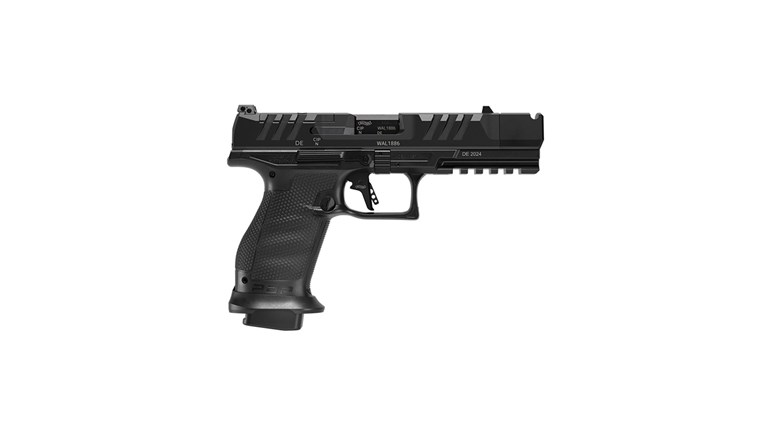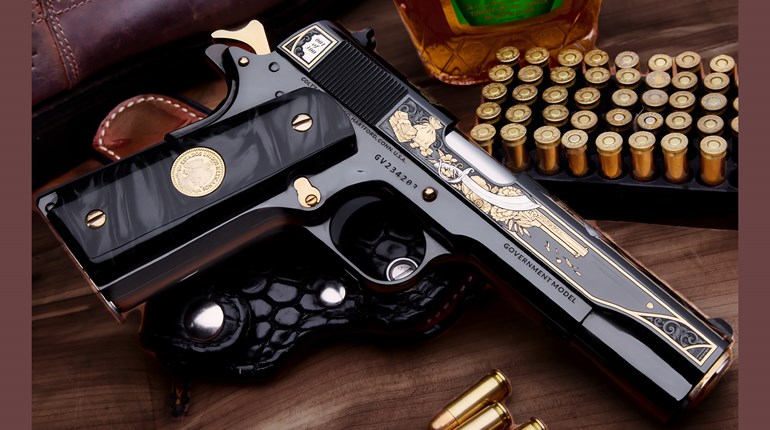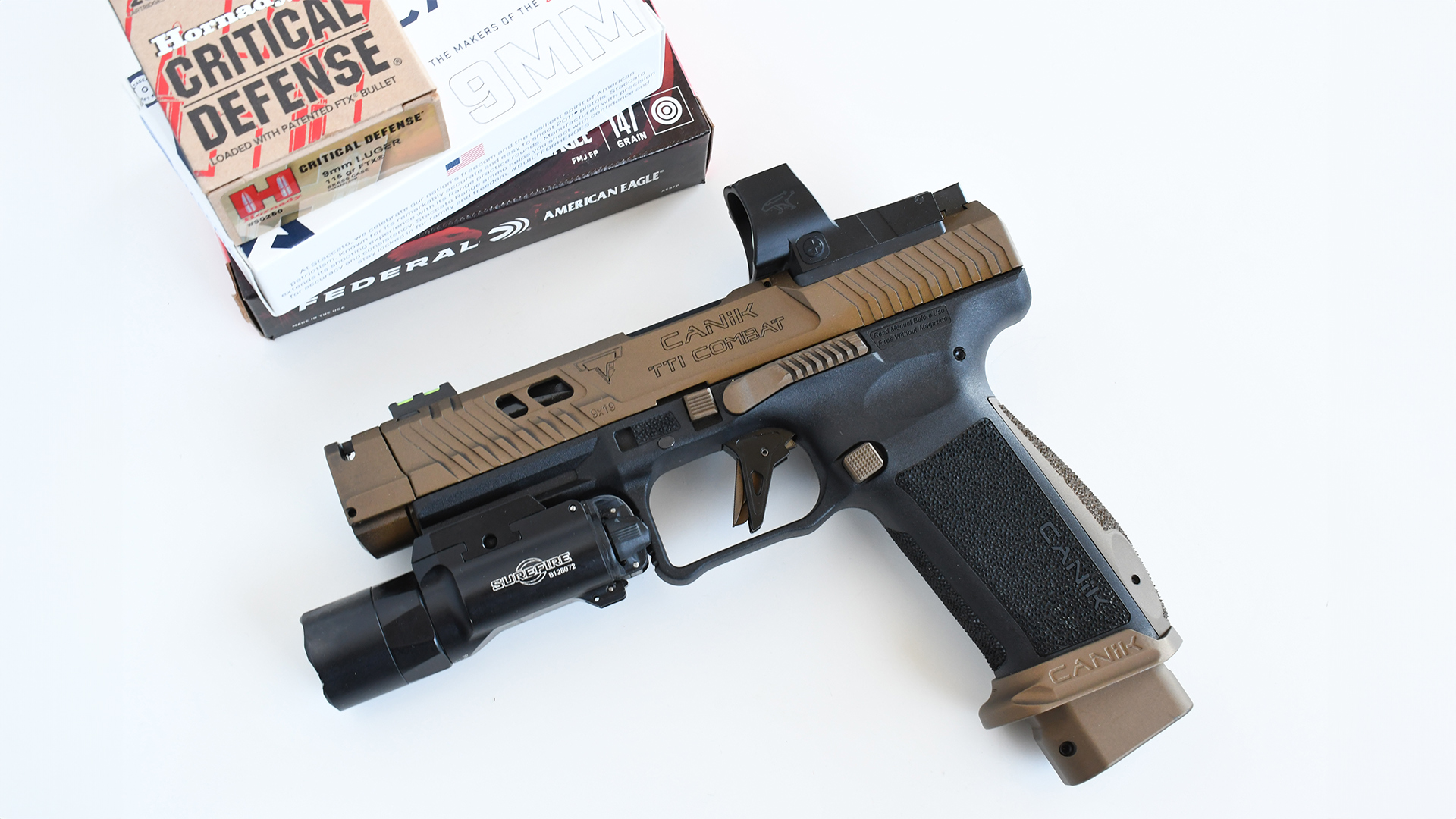
Canik, the Turkish gun company whose products are imported by Century Arms, has been present in the U.S. market for about a decade now. While the company cemented its reputation by selling affordable guns that punch above their weight, Canik has also slowly been building up another reputation as a serious company that can cater to performancefocused shooters. Canik first released the Rival in 2022, followed by the steel-frame version (Rival-S) in 2023. And for 2024, Canik introduced the TTI Combat. This release is unique because the TTI Combat is Canik’s first factory-compensated and ported pistol, and it’s the company’s first high-profile collaborative effort with an established entity in the performance pistol space—the famous Taran Butler of Taran Tactical Innovations.
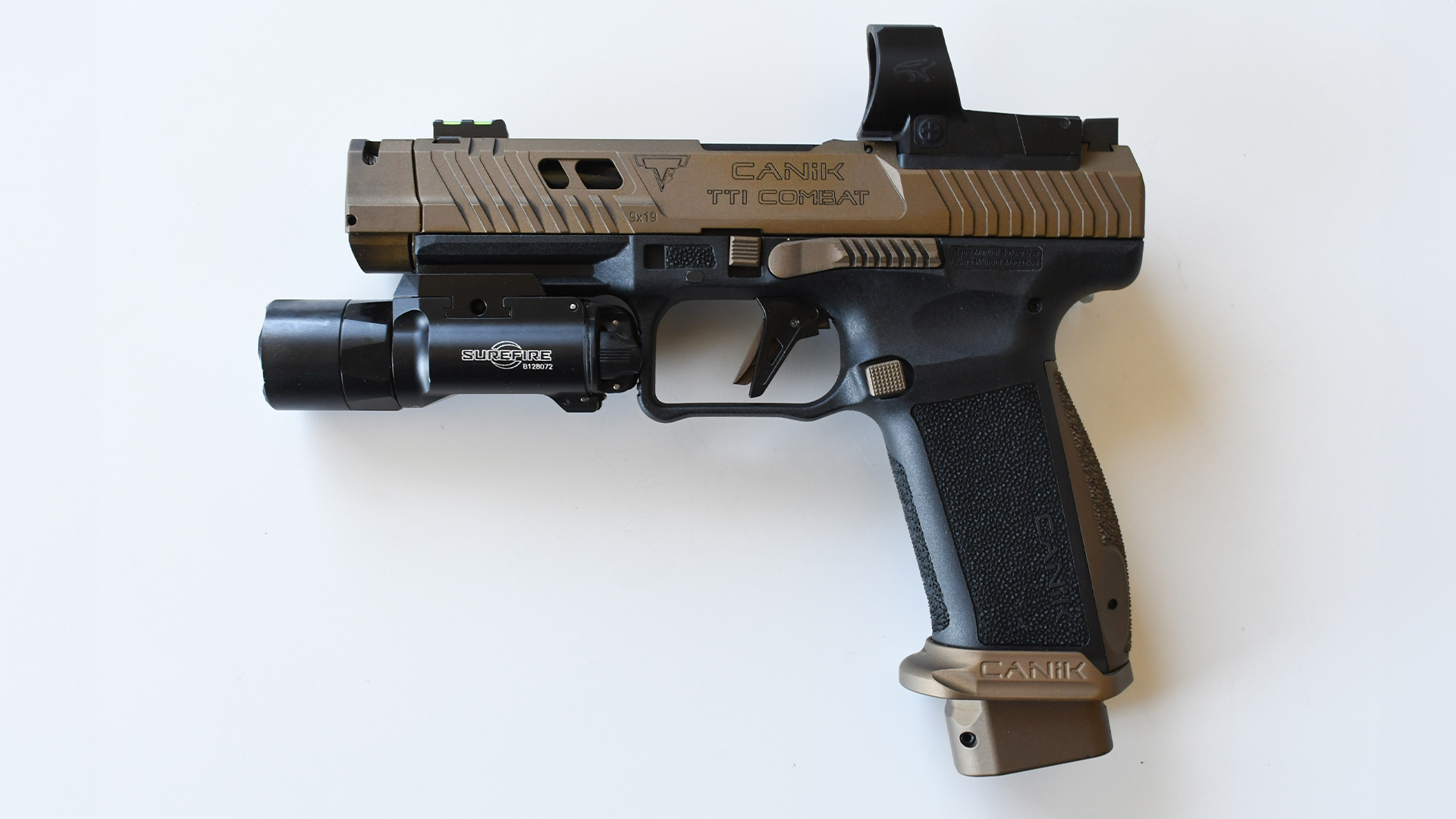
Canik TTI Overview
Like most other Caniks, the TTI Combat is a striker-fired handgun chambered in 9 mm Luger with a polymer frame that uses Canik’s reliable semi-automatic action, which itself is based on a simplified version of the renowned Walther P99’s action. The most succinct way to describe the TTI Combat—it’s a full-size Canik METE fully done-up to TTI’s specifications. Every aspect and detail of this gun has been combed over, and the resulting product has both physical and cosmetic features that differ from a standard METE. The gun includes a distinctive twotone Cerakote bronze finish, along with other bronze accent pieces that are juxtaposed against a black frame and trigger. Otherwise, the TTI Combat is just like its full-size METE counterpart. Frames and slides are interchangeable, and the TTI Combat’s slide even has the Shield RMSc-sized factory cut of the METE—not the larger one present on the Rivals. The gun I’m reviewing here is set up identically to the gun that was on display at SHOT Show earlier this year at Century Arms’ booth, with Canik’s new-ish “big window” competition-style reflex sight, the Mecanik M03.
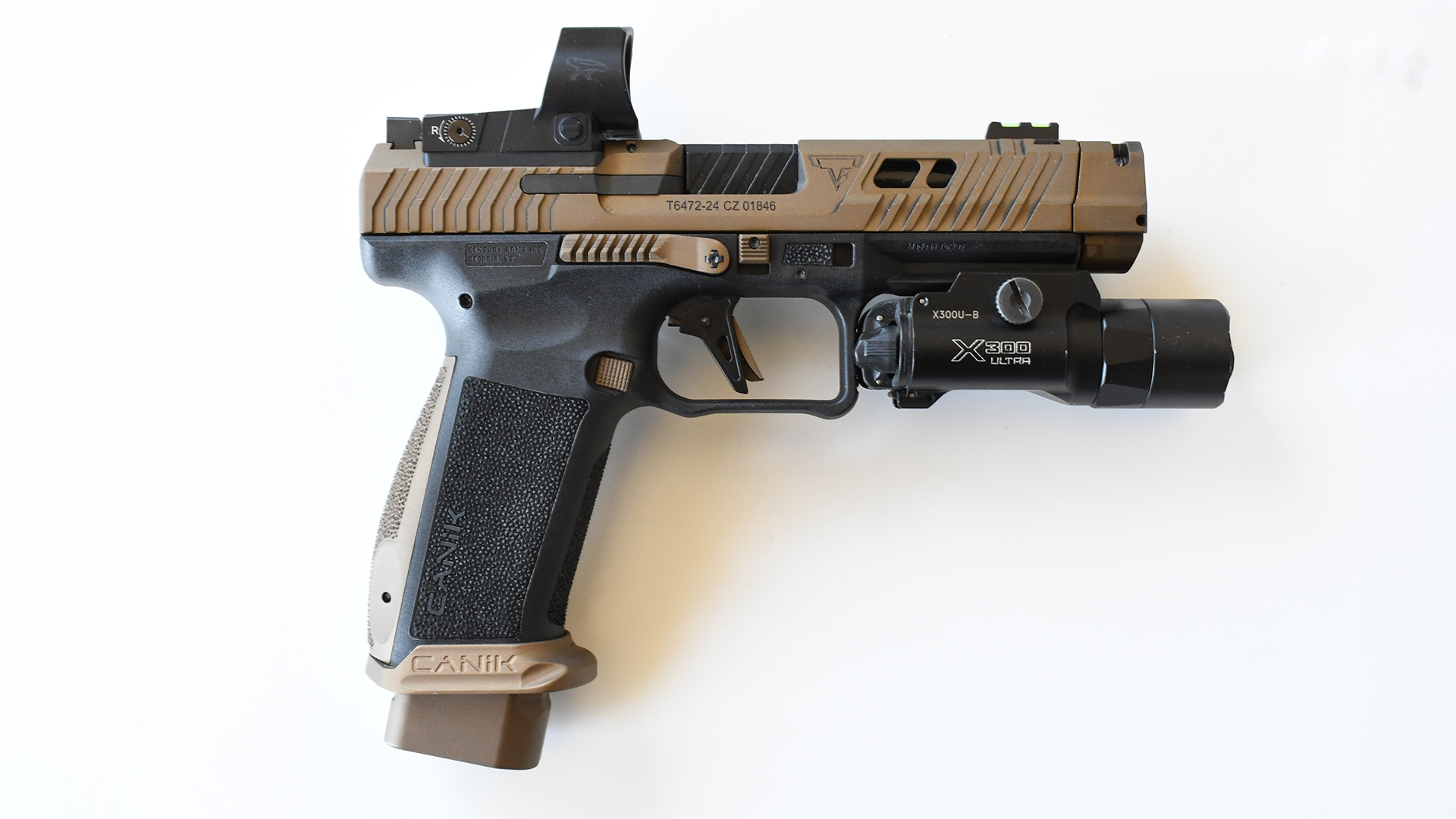
Slide, Sights & Optics Mount
The Canik TTI Combat’s slide has a distinct forward-and-rear serration pattern. Similarly, it has lightening cuts on the slide forward of the breech on the top and sides; these follow the same style and pattern as seen on Glocks and double-stack 1911s worked over by Taran Tactical Innovations. The slide itself has a distinctive bronze Cerakote finish, along with a stylized engraving that reads “Canik TTI Combat” and the TTI logo over the middle of the left side. Like the METE, it also has a hinging loaded-chamber indicator just above the breech face. The slide itself is the same overall length as the METE SF’s slide.
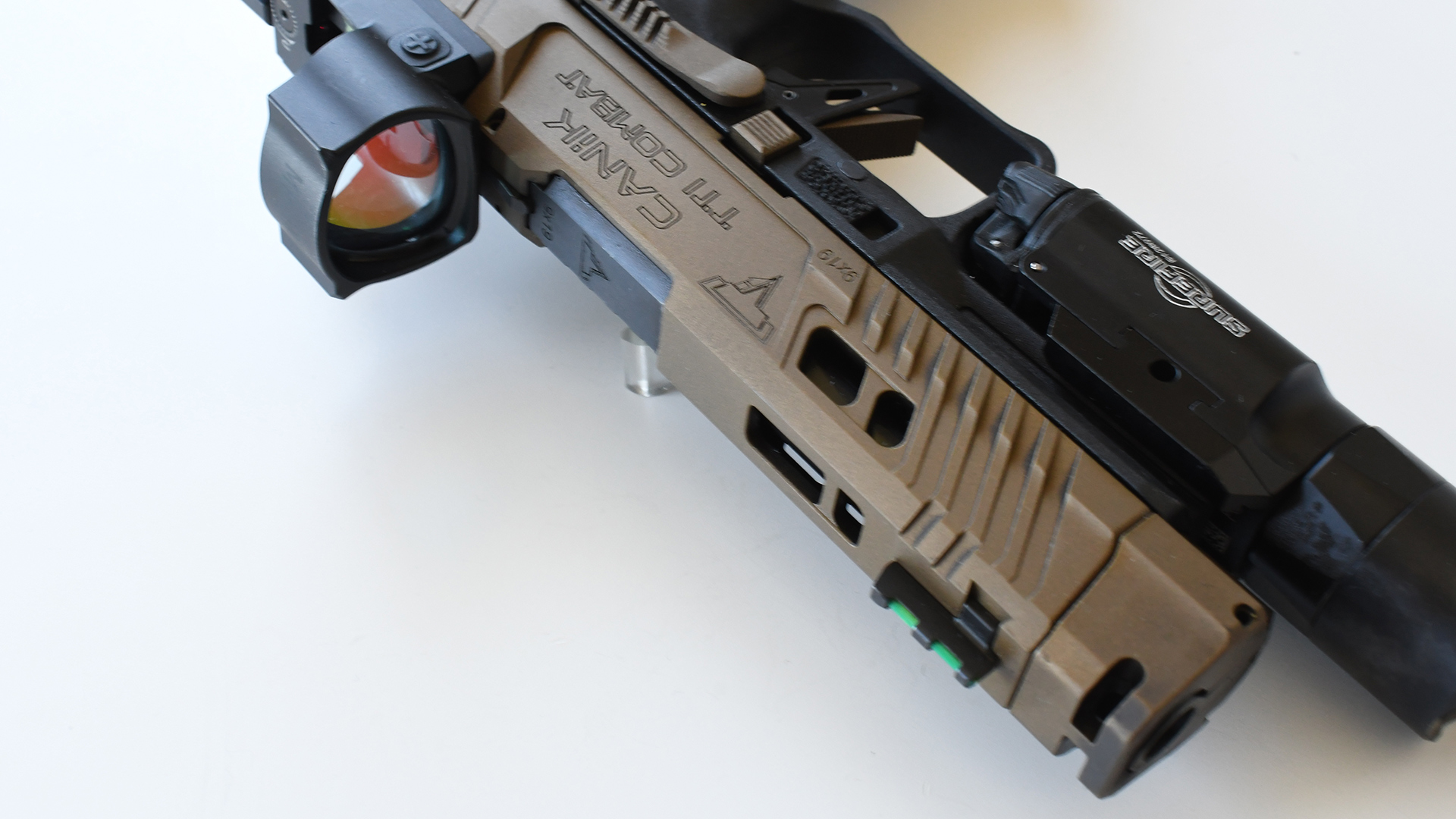
Though all my shooting involved using the Mecanik M03 red-dot sight, I couldn’t help but to notice how fantastic the iron sights are. The dovetailed rear sight is plain and serrated with a deep and spacious notch and the front sight tall and thin. A green fiber-optic insert sits inside this front sight, with a bias towards the top edge. For iron-sighted shooting sports divisions, the sight picture provided by this scheme has a lot to offer competitors. When I first saw the gun at SHOT Show 2024, I assumed the slide had the same factory cut as the Rival series. However, as mentioned above, it’s a METE pattern factory cut. Three footprint-specific plates are included, but they’re more like shims sandwiched between the slide and optic’s footprint. Two are compatible with the Shield RMSc pattern and the third is for the Trijicon RMR/SRO footprint. Also worth mentioning—this RMR-pattern shim isn’t nearly as thick as the RMR-pattern factory plates included with the Rival.
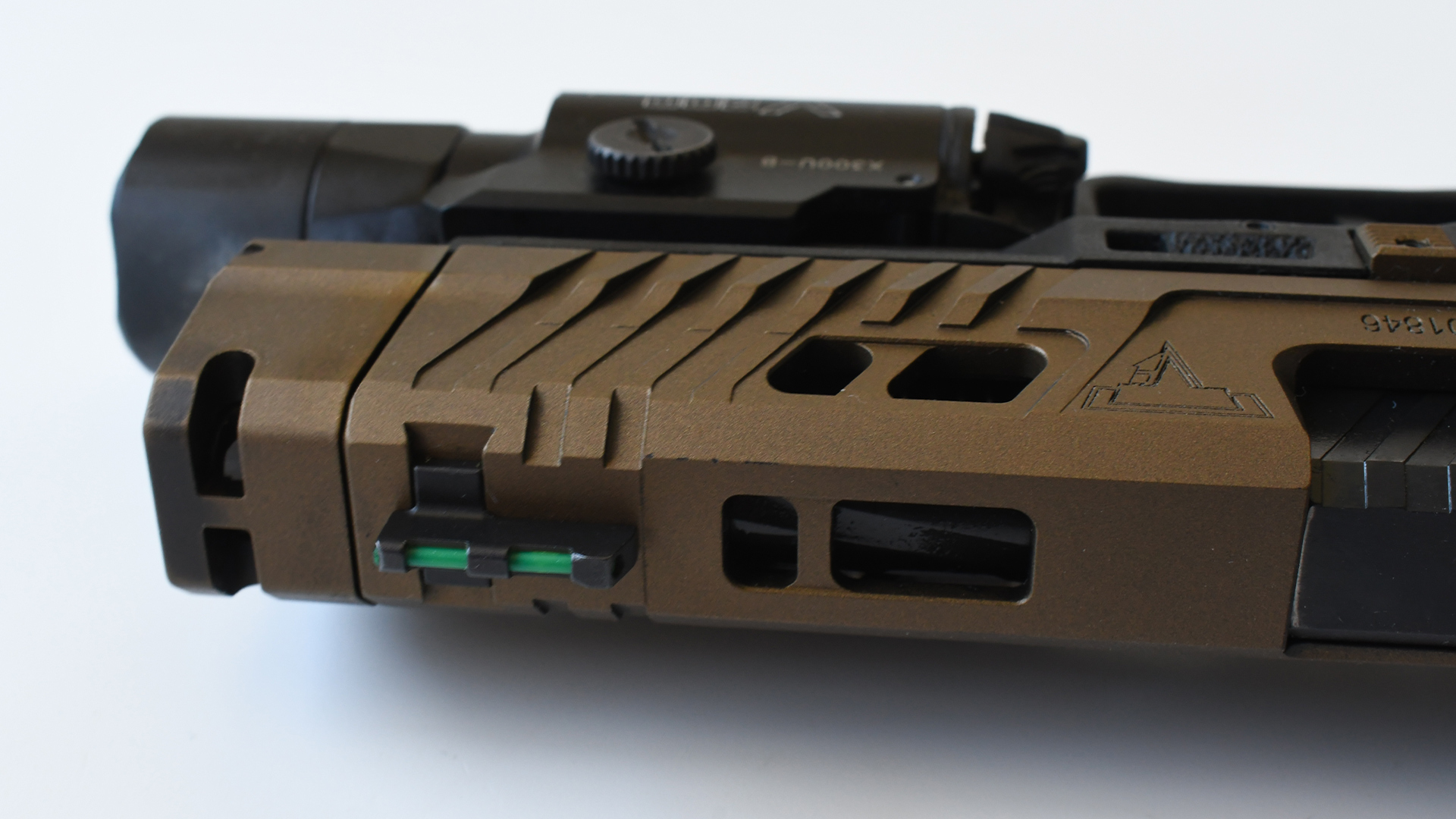
Barrel & Compensator
Because the Canik TTI Combat was designed around shooting with its proprietary single-port compensator, its barrel is equally unique. In addition to fluting, it omits threading and the compensator itself sits flush with the muzzle. Instead of threading, there’s a groove pattern that allows the compensator to pivot and slide in place. Underneath the muzzle there is a vertical lever meant to be pushed with a punch that serves as the compensator’s “quick-detach” solution. To account for both the flush-fitting compensator and the lack of traditional muzzle threads, the top of the barrel directly behind the muzzle has a single lateral port cut into it. In the proper position, the compensator lines up directly with its own port over the barrel’s port cut. My round-count for this review was roughly 350 rounds, and I had no issues with the compensator shaking itself loose, even after aggressive shooting in an action-pistol match.
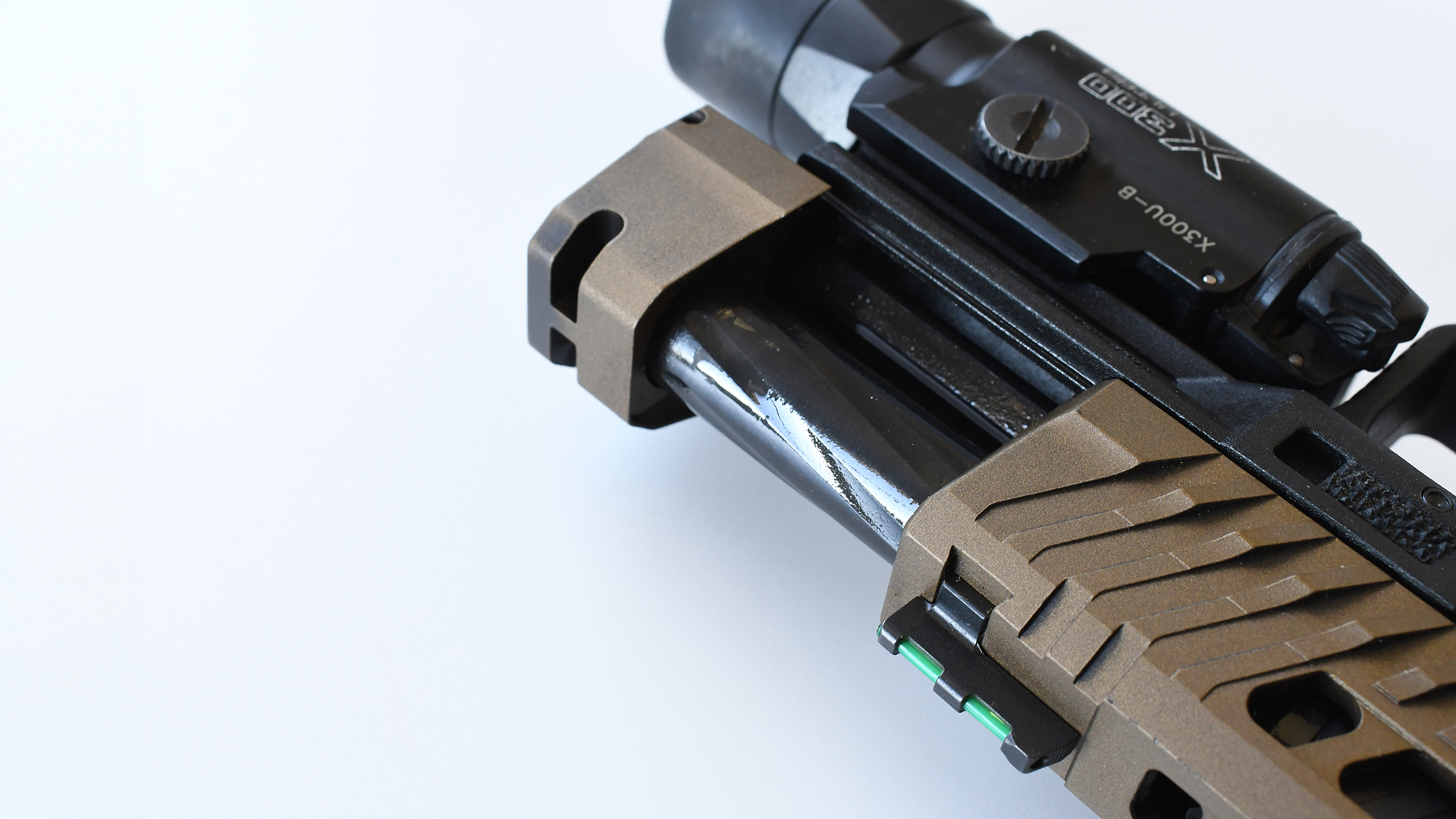
Grip, Frame & Trigger
Generally, Canik double-stack pistols have a grip angle and shape that I consider to be conservative and useful to most hand sizes. Although these grips may lack additional contouring and undulations found on other contemporary striker guns, the angle of the grip is exactly where it needs to be, while the circumference has an oval taper so that the grip doesn’t feel like a piece of 2x4 lumber in the hand. All in, these Turkish pistols have agreeable grips both in compact and fullsize guns. That said, the problem with most Canik guns is that their grip texture tends to be on the milder side. The TTI Combat instead has the same great grip, but with a higher level of aggressive texturing, which is perfect for the performance-driven shooting applications the gun is meant for. It’s readily noticeable when picking up and gripping the gun. The interchangeable backstraps also include this aggressive texturing with the added bonus of having the same matching bronze color as the TTI Combat’s slide. Similarly, the provided aluminum magwell is also bronze colored. Besides the improved texturing, the frame is similar to other Canik frames. The large squared-off trigger guard provides plenty of space for the support hand’s index finger to push-off from, while also having a reasonable degree of undercutting where it meets the front strap. Additionally, the frame’s dustcover has a Picatinny rail for accessories
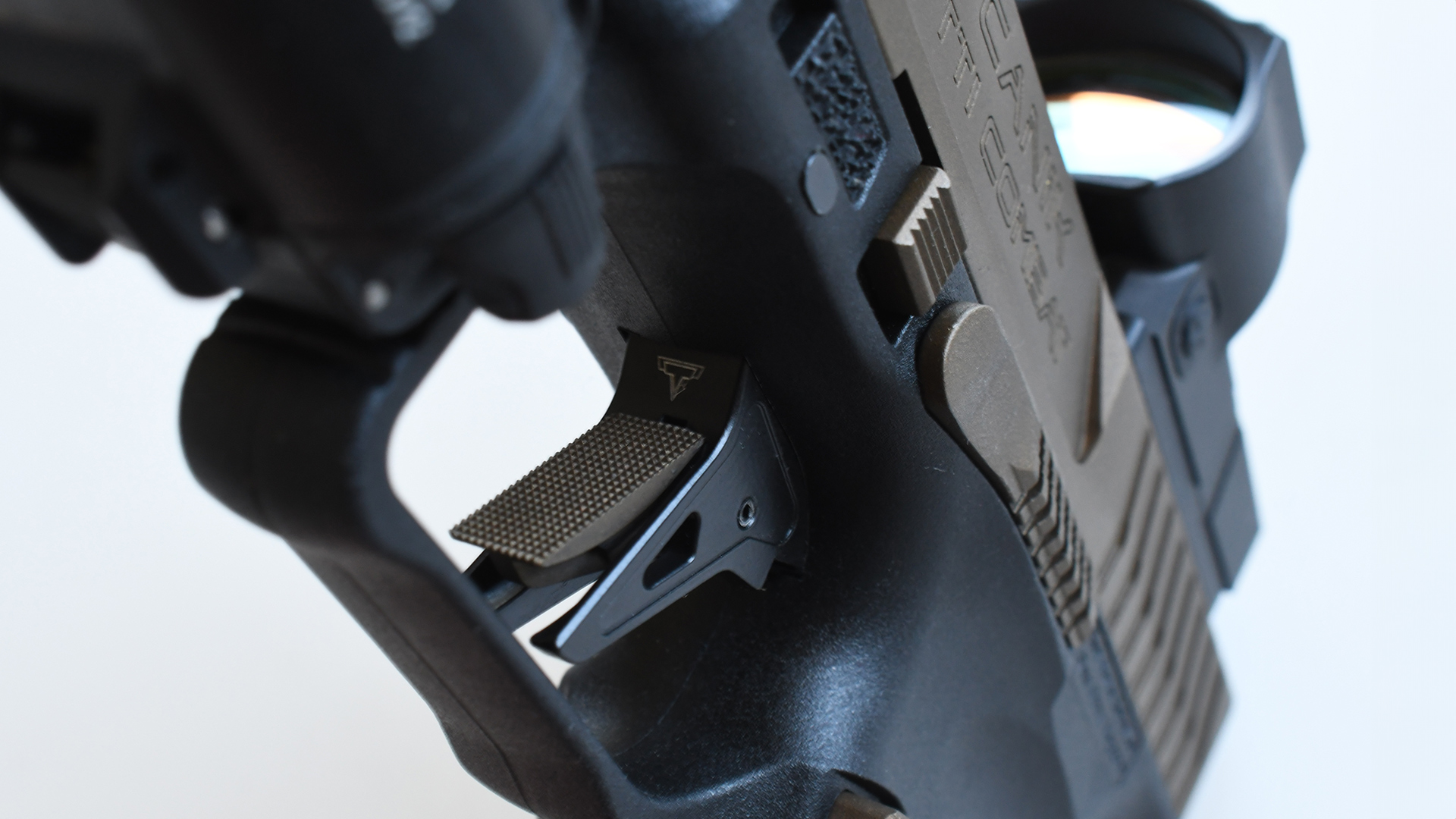
The Canik TTI Combat’s trigger is identical to ones found on the Rival series. Arguably, these triggers are one of the pivotal factors in these guns’ accuracy and easy shootability. It’s one of the best striker-fired, competition-style triggers found on production guns these days. On an electronic trigger-pull scale, 10 trigger pulls from the TTI Combat averaged three pounds, six ounces. The trigger’s flat face is nearly 90 degrees and includes a wide, comfortable and checkered bladed safety. The safety itself takes up nearly the entire width of the front face and feels seamless when depressed. Because it’s so flat, shooters don’t need to worry about their trigger-finger pad becoming irritated over extended firing sessions. Pre-travel is roughly 1/4-inch and it resets after moving roughly 1/8-inch forward. It can’t be overstated what an asset it is to the TTI Combat as a whole.
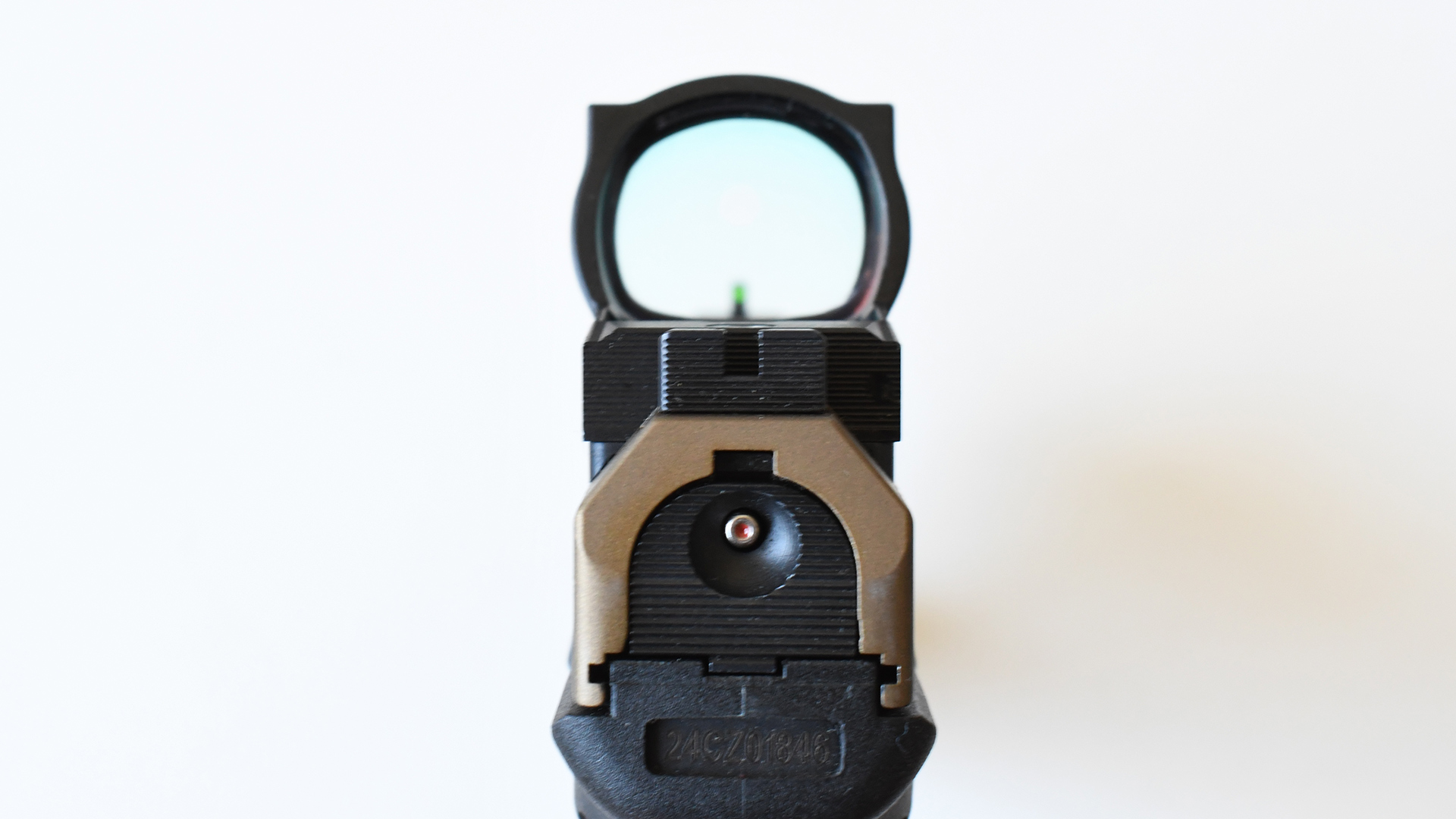
Carrying Case & Accessories
The Canik TTI Combat ships in a hard-sided plastic case meant for convenience much in the same way as the steel-framed Rival-S. This case is full of additional tools, accessories, extra hardware and a right-handed, competition-style holster. Since the TTI Combat is a special edition, it also includes an encased medallion sporting the Canik and TTI logos. Additionally, Canik provides a low-power lighter recoil spring assembly in the case for use with softer-shooting, competition-tailored 9 mm Luger loads.
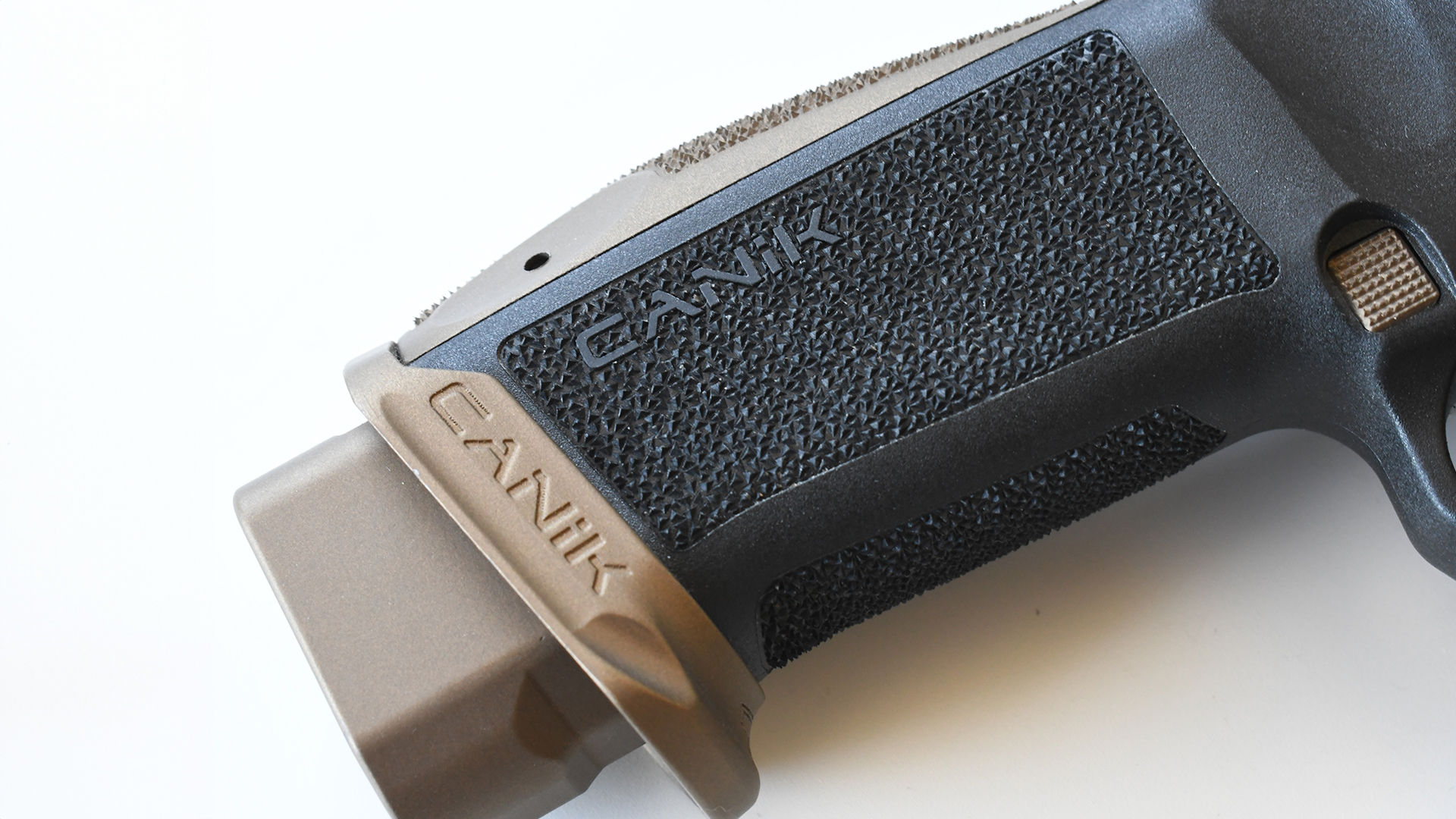
Canik TTI Combat at a Match
I brought the TTI Combat to my local weekend match. For USPSA- and IPSC-style events, one will have to enroll in the Open division, with minor scoring. Though IDPA’s compensator rules can be subject to interpretation, my understanding is that the Canik TTI Combat is IDPA-legal, too. During the match, I don’t actually remember shooting the gun all too much, which is a good thing. By this I mean that I connected well with the gun and I wasn’t consciously focusing on the gun itself. Rather, I was putting bullets where they needed to go. If anything, I could have pushed harder and the gun would have still “had my back.” Finally, the inclusion of the Mecanik M03 sight was the cherry on top, as its big window and six-MOA dot are perfect for fast-paced shooting.
All in, I fired approximately 350 rounds through the TTI Combat. As usual, I cycled both handloads and factory ammunition through the gun, which has been reliable to date. For accuracy evaluation, I fired 115-grain Hornady Critical Defense jacketed hollow-point, 124-grain Staccato Range full-metal jacket and 147-grain American Eagle full-metal jacket flat-point rounds. Across the board, accuracy for all three factory loads was satisfactory, and the stock recoil spring had no issues cycling these rounds. The bulk were fired through the TTI Combat for the review, and at my match were handloads consisting of a 147-grain Berry’s plated round-nose .356-inch bullet over 5.2-grains of Blue-Dot. Though not part of my official review, these had an average muzzle velocity of 986 f.p.s. (Power Factor: 145), and a 10-shot group at 25 yards had a 2½-inch extreme edge-to-edge spread—more than adequate for the type of competitive shooting I do.
Accuracy Table

Bottom Line
As far as performance goes, the TTI Combat is a capable gun. With any good red-dot optic, its excellent match-grade trigger and aggressively textured grip, the gun basically shoots itself and can help free your mind to better focus on the competition. The compensator also helps, but due to physics and an entirely different series of articles on compensators, propellants and ammunition, I don’t believe it’s the single most important driving factor behind the gun’s performance. I also didn’t find the lighter-than-steel plastic frame to be too jumpy or to have a radically different recoil impulse; I was too busy watching the dot perfectly track during shooting. Compensator or ammo selection aside, it didn’t take much for the TTI Combat to prove itself as a reliable, solid shooter.
It’s not lost on me that Taran Tactical Innovations products are expensive and come with ultra-long lead times, so the new Canik TTI Combat gives the shooting public a chance to buy a TTI-affiliated product for less than $1,000 that also includes a bonafide performance package. Go to canikusa.com to learn more.
Canik TTI Combat Specifications
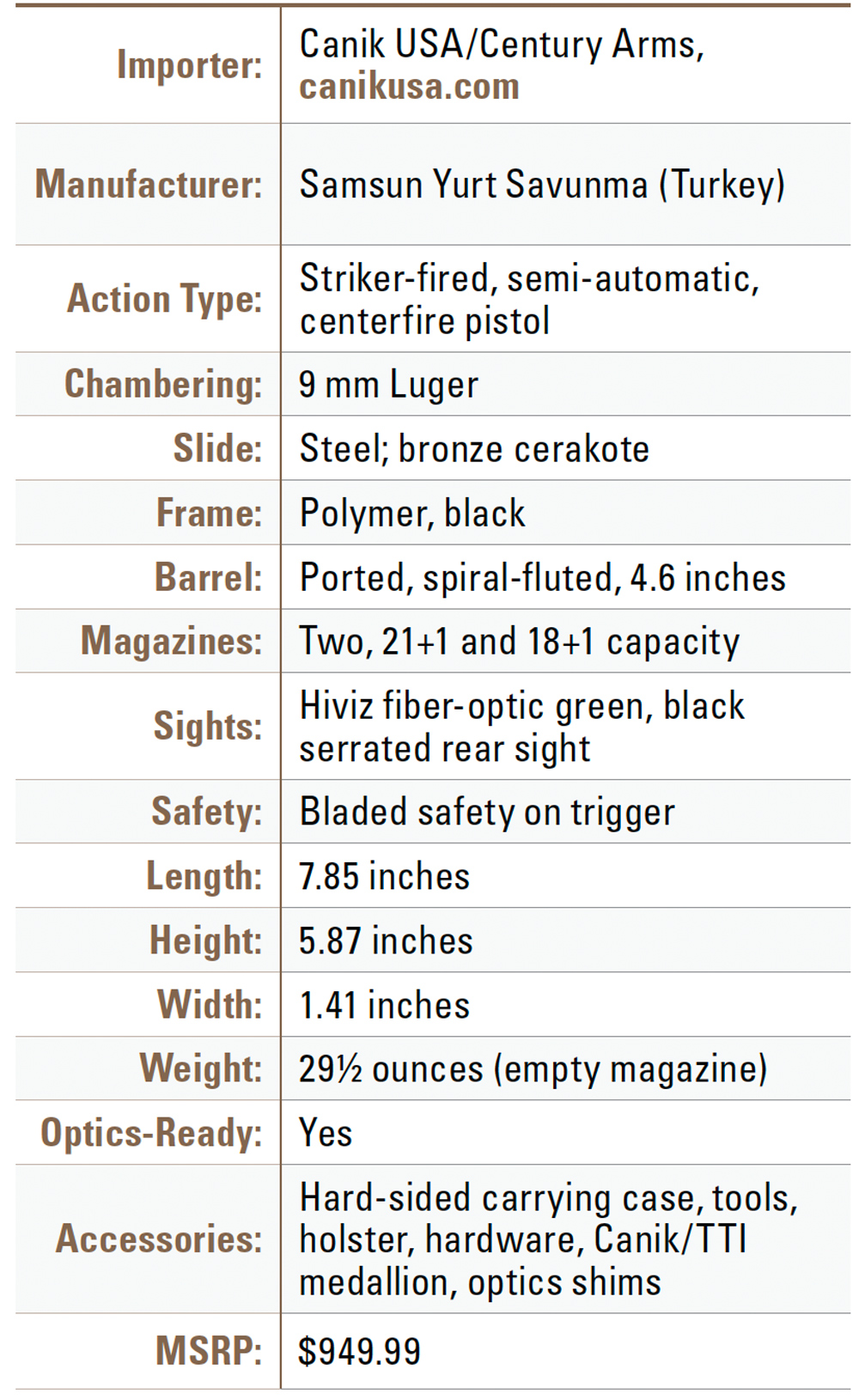
All photos by P.E. Fitch.














